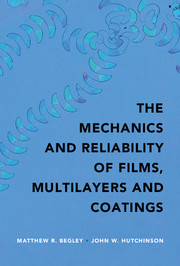Book contents
- Frontmatter
- Contents
- Acknowledgements
- Notation
- 1 Introduction
- 2 Key Mechanics Concepts
- 3 Linear Elastic Fracture Mechanics
- 4 Steady-State Delamination of Bilayers
- 5 Steady-State Delamination in Multilayers
- 6 Steady-State Channeling and Tunneling Cracks
- 7 Crack Kinking from an Interface
- 8 Crack Penetration, Deflection or Arrest?
- 9 Edge and Corner Interface Cracks
- 10 Buckling Delamination
- 11 Delamination of Thin Strips (Patterned Lines)
- 12 Delamination in Multilayers Subject to Steady-State Temperatures
- 13 Cracking under Transient Temperature Distributions
- 14 Software for Semi-Infinite Multilayers: Steady-State Delamination
- 15 Software for Semi-Infinite Multilayers: Transient Delamination
- 16 Finite Element Software for Multilayers: LayerSlayer FEA
- 17 Convergence and Benchmarks with LayerSlayer FEA
- Appendix Asymptotic Crack Tip Displacement Fields for an Interface Crack
- References
- Index
15 - Software for Semi-Infinite Multilayers: Transient Delamination
Published online by Cambridge University Press: 13 July 2017
- Frontmatter
- Contents
- Acknowledgements
- Notation
- 1 Introduction
- 2 Key Mechanics Concepts
- 3 Linear Elastic Fracture Mechanics
- 4 Steady-State Delamination of Bilayers
- 5 Steady-State Delamination in Multilayers
- 6 Steady-State Channeling and Tunneling Cracks
- 7 Crack Kinking from an Interface
- 8 Crack Penetration, Deflection or Arrest?
- 9 Edge and Corner Interface Cracks
- 10 Buckling Delamination
- 11 Delamination of Thin Strips (Patterned Lines)
- 12 Delamination in Multilayers Subject to Steady-State Temperatures
- 13 Cracking under Transient Temperature Distributions
- 14 Software for Semi-Infinite Multilayers: Steady-State Delamination
- 15 Software for Semi-Infinite Multilayers: Transient Delamination
- 16 Finite Element Software for Multilayers: LayerSlayer FEA
- 17 Convergence and Benchmarks with LayerSlayer FEA
- Appendix Asymptotic Crack Tip Displacement Fields for an Interface Crack
- References
- Index
Summary
In this chapter, we describe software that analyzes the time-dependent thermal response of multilayers, called LayerSlayer Transient (LST). As with its counterpart for steadystate analysis described in the previous chapter, the software is based on the onedimensional heat conduction framework described in Section 2.6 and the general framework for multilayer mechanical analysis described in Chapter 5. The distinction is that LST solves for transient, time-dependent temperatures, whereas LS solves only for the steady-state response. LST is subject to the same geometry restrictions as LS and the same assumptions regarding deformation. Though each code can be used independently of the other, the reader is encouraged to become familiar with the conceptual framework of LS prior to exploring LST.
In LST, all of the governing equations described in Chapter 14 for LS now become functions of time. Whereas LS solved for temperatures at discrete points via linear algebra using [K]﹛T﹜ = [q], LST determines temperatures at discrete points as a function of time by solving the coupled first-order differential equations. It is important for the user to keep this difference in mind, particularly in light of the fact that the inputs and outputs of both pieces of software are extremely similar. However, in LST, one must always specify the time at which an output variable, such as stress or energy release rate, is sought. A powerful feature of Mathematica is that it solves coupled systems of differential equations with ease and automatically produces interpolation functions for nodal temperatures that enable one to easily extract results for any point in time.
The second important distinction between LS and LST is that LST requires that the physical layers that make up a multilayer are subdivided into ‘elements’, such that nonlinear spatial distributions of temperature within a single layer can be captured. This means that temperatures are computed at discrete points within each layer (not just at the interfaces), leading to much larger systems of equations. Within each element, the temperature distribution is assumed to be linear; LST essentially determines a piecewise linear distribution of temperatures that converges to the true nonlinear distribution as the number of elements are increased.
Information
- Type
- Chapter
- Information
- The Mechanics and Reliability of Films, Multilayers and Coatings , pp. 208 - 226Publisher: Cambridge University PressPrint publication year: 2017
